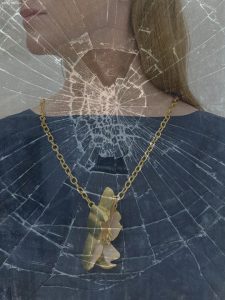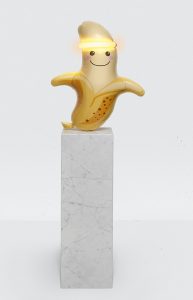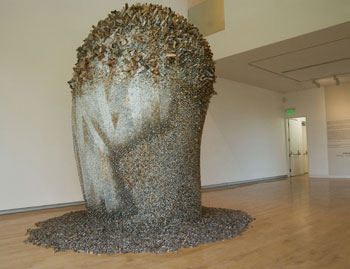
The Aldrich, long known for being one of the best contemporary art museums in New England (and a popular weekend trip for many New York art junkies), has put together another formidable display this spring. Much of the success can be attributed to the curators Monica Ramirez-Montagut and Richard Klein and director Harry Philbrick, in no small part because they have worked so closely with each artist in the space.
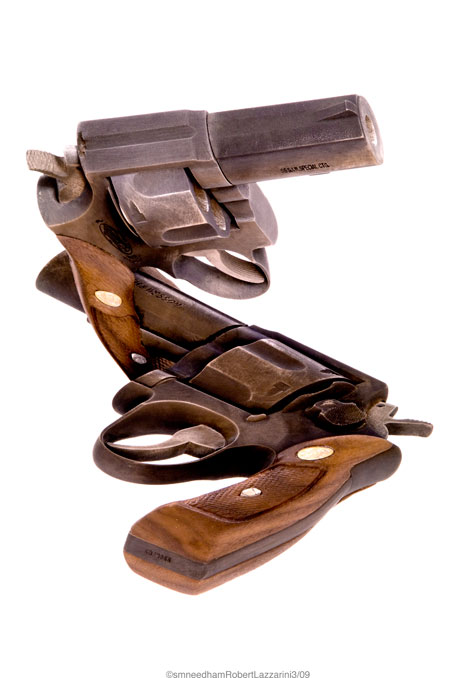
In the first exhibition space, Robert Lazzarini’s installation Guns and Knives shows just how crucial the relationship between artist and the space really is. Lazzarini’s sculptures are mounted in a room with diffused lighting and angular walls. The effect is a reversal of the traditional trompe-l’œil, and one feels hesitant to approach the sculptures for fear of walking smack into a wall. Even up close, the eye wants these three dimensional pistols and knives to lay flat against the wall. Lazzarini’s actual execution of the sculptures, using real carbon steel and wood is fantastic. The illusion is created, the artist states, by “mathematical distortions, wherein if you augment one part, you affect the whole.” In this case, a slight shift in geometrical proportion does the trick. The continuation of this distortion is created by the augmented walls and diffused lighting, and credit must be given to the Aldrich team. The space is so cleanly and subtly altered that it takes a few seconds to really appreciate the modification. The distortion is so well done that it’s not an exhibition one can really linger in for long. And at least for me, there was a relief upon exiting the space and returning to the traditional upright walls and lighting of the lobby, my nausea tamed.

Down the hall from Guns and Knives, David Taylor’s show Frontier/Frontera is a quiet exhibition composed of three distinct parts, A measure of Faith and a Line in the Sand, Working the line, and Frontier/Frontera. The difference between social documentary and art is increasingly more often than not a judgment call but Taylor’s photographs are so beautiful, this particular exhibition leaves little doubt of his artistry. The hot and dry vastness of the Mexico / US border and the visible tension between immigrants and border patrol are portrayed with a mutual empathy for both sides. Ramirez-Montagut’s introduction to the exhibition focuses mainly on what is being documented, where both perspectives reveal an “erosion of traces of traditional, ancient, historical and peaceful coexistence, as they cede their place to ownership based on distant surveillance.” To be sure, this is an important part of Taylor’s art, though what remained with me was the actual framing of the photography and video pieces, the sequential series of portraits and still-life prints along the outside wall, distinctly part but separate to the rest of the exhibition, and most importantly, the audio. Taylor’s wide format prints of the border brought the color, expanse and heat of the border, but the audio component revealed just how small a voice sounds in such an open country. Even the most mundane conversation from the border patrol took on a heightened importance in the gallery – the clear sound of geographical and cultural divide.
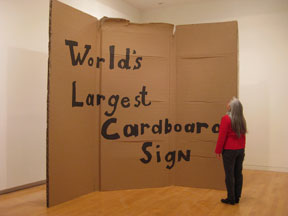
Alejandro Diaz’s Blame it on Mexico is another series focused on US / Mexican relationships, both culturally and politically. It is great to see art institutions showing more support for Mexican art, though it is hard not to draw direct comparisons and contrasts between Diaz’s show and Taylor’s, in spite of them existing on two different floors in the museum. It is not clear whether or not this relationship is intentional, and because of this, I feel that both exhibitions suffer a loss of limelight. Putting this aside, Diaz’s Blame it on Mexico is hilarious, poignant and lively. A series of installations, sculptures and mixed media works are used to attack stereotypes, cultural misunderstanding, and the socioeconomic gap that exists on both sides of the border. Each room in Diaz’s exhibition are wonderful, the best of which is the installation Make your own damn tortillas, where a corner of the room is transformed into a Mexican tortilla camp, but the worker has long since left. Diaz has won most fame using a series of cardboard signs with humorous messages such as “There’s no place like the homeless,” “Does this sign make me look fat,” or “By disappointment only” to pose the problem of medium versus message. The use of the cardboard sign is intentionally very obvious. The cardboard sign is a well-recognized method of communication that carries a heavy stereotype. Diaz works this loaded symbol to create a precise commentary on racial tensions and assumptions, the black humor (reminiscent of Mark Newgarden’s We All Die Alone) is absolutely bittersweet, and not in the least bit cute as some may suggest. Funny but only because it is terribly sad.

The last exhibition I saw was Kwang-Young Chun’s The Soul – Journey to America, which displayed a lone sculpture entitled 08-AU22 in a small room at the back of the museum. A massive and fungus-shaped figure, 08-AU22 is composed of thousands of Styrofoam shapes wrapped in old Korean print paper. Teetering, lumbering but seemingly solid, the figure is set against the windowed backdrop of the Connecticut country side, looking as much at home out there as it appears in the space. Curator Richard Klein notes the cultural importance of mulberry paper in Korea, especially during the 1960s where it was “commonly used for wrapping, packaging, writing as well as publishing books and periodicals.” Klein draws a distinct connection between the voices of Chun’s culture through these printed papers, and the organic composition of the sculpture, suggesting that the “cacophony of handwritten words (…) seems to literally summon the dead.” The surface of the sculpture is remarkable, with derivations, obtrusions and overarching shapes that lend themselves to the idea of this thing being some sort of large plant or mushroom. If, as Klein suggests, each of these wrapped pieces does represent a voice, 08-AU22, with its documented date and year for a name, could be a snapshot of Chun’s culture, each piece adding something to the greater whole.


